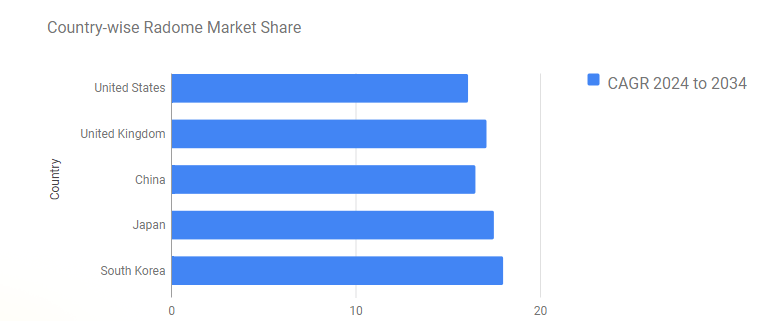Radomes, those often-overlooked guardians of the electromagnetic spectrum, play a vital role in various industries. These protective enclosures shield delicate antennas and sensors from harsh environmental elements while ensuring optimal signal transmission and reception. Driven by advancements in technology and the growing demand for reliable communication and navigation systems, the Radome Market is experiencing a surge in popularity. Let’s delve into the diverse applications of radomes and explore the exciting factors propelling this dynamic market forward.
Protecting the Signal: Applications of Radomes
Radomes come in various shapes, sizes, and materials, each designed for specific applications:
- Aerospace and Defense: Aircraft, missiles, and satellites rely on radomes to shield radar antennas and communication systems from rain, hail, wind, and debris during flight. This ensures uninterrupted signal transmission and reception, critical for navigation, weather detection, and secure communication.
- Telecommunications: Radomes protect communication antennas on cell towers and other infrastructure from the elements, safeguarding signal quality for mobile phone networks, internet connectivity, and other wireless communication systems.
- Weather Monitoring: Weather radars utilize radomes to shield their sensitive antennas from harsh weather conditions like snow, ice, and high winds. This ensures accurate weather data collection for forecasting and early warning systems.
- Broadcast and Satellite Communications: Large radomes protect antennas used for satellite communication and broadcasting. These radomes ensure reliable signal transmission and reception for radio, television, and satellite internet services.
- Military and Law Enforcement: Military and law enforcement agencies use radomes to shield radar systems on ground vehicles, ships, and surveillance equipment. This ensures effective target detection and communication for security and defense applications.
Request Your Sample Report for Free: https://www.futuremarketinsights.com/reports/sample/rep-gb-19011
A Market on the Rise: Growth Factors and Opportunities
The Radome Market is experiencing significant growth driven by several key trends:
- Rise of Autonomous Vehicles: The development of self-driving cars necessitates reliable radar and LiDAR systems, which rely on radomes for protection and optimal performance.
- Expanding Telecommunications Infrastructure: The growing demand for mobile internet and data connectivity is driving the need for more cell towers and communication infrastructure, all requiring radomes for antenna protection.
- Focus on Weather Monitoring: With increasing concerns about extreme weather events, investments in weather radar systems and their protective radomes are on the rise.
- Advancements in Radome Materials: Manufacturers are constantly innovating, developing lightweight, durable, and weather-resistant radome materials that offer superior signal transparency.
- Growing Military Modernization Programs: Military modernization efforts around the world are leading to increased demand for advanced radar and communication systems, all requiring robust radomes.
According to a Future Market Insights (FMI), the radome market is estimated to be worth USD 3.5 Billion in 2024 and is projected to be valued at USD 15.1 Billion in 2034. Between 2024 and 2034, the industry is expected to register a growth rate of 15.8%. The increasing demand for radar systems across diverse sectors such as defense, aerospace, telecommunications, and meteorology stands as a pivotal catalyst propelling the growth of the radome market.

Key Companies:
- Lockheed Martin Corporation
- Raytheon Technologies
- L3harris Technologies
- Northrop Grumman Corporation
- BAE Systems
- Thales Group
- Saint-Gobain
- General Dynamics Nordam
- Comtech Telecommunications
- Cobham PLC
Get Full Report Now: https://www.futuremarketinsights.com/checkout/19011
Challenges and Considerations
The Radome Market also faces some challenges:
- Balancing Cost and Performance: Finding the right balance between cost-effective materials and optimal performance for specific applications is crucial.
- Environmental Considerations: The environmental impact of radome materials, particularly during disposal, needs to be addressed with sustainable solutions.
- Frequency Range Specificity: Radomes need to be designed for specific frequency ranges to ensure optimal signal transmission and reception across different applications.